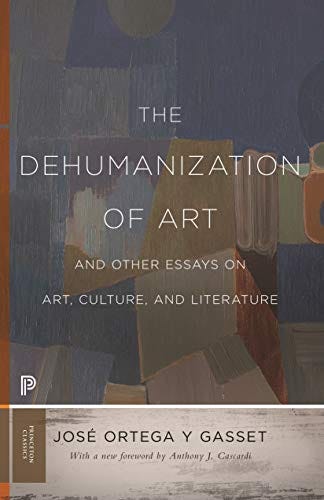Was José Ortega y Gasset correct?
In this follow-up piece to a review, I assess how accurate Gasset's 1925 essay "The Dehumanization of Art" was.
Following my book review, we should consider in which ways Gasset was correct (with regard to the essays under consideration), we have to take into account that the era of Modernism is now past. We exist in a persistent series of reverberations that comprise Post-Modernism and whatever the new state may be called. For 50 years we have inhabited an ante-room to the main theatre, receiving tales of great deeds. We are approaching a stage where none of us has spoken to a great artist or seen a newly made work of art that has greatness. The radical innovations that Gasset wrote of – and ones he could not have anticipated – are now the cornerstones of a great temple that has been complete since before any of us were born.
Firstly, Gasset seems to have been correct about society generally. “Today children want to prolong their childhood, and boys and girls their youth.”[i] In an era of kidulthood and “adulting is hard”, Gasset could hardly have been more correct in 1925, although one suspects that he could not have anticipated how far we have fallen. A trivial point, but one in his favour.
We find that although Gasset subscribed to elite theory (inasmuch he saw elites governing the populace as inevitable, natural and divorced from questions of correct government) he was not a supporter of Modernism because it was elitist per se. He disliked High Modernism. (“[T]he new art has so far produced nothing worth while […]”[ii]) Yet he declares (ominously for the trads) “there is no turning back”.[iii] He accepted avant-gardism as both social-signalling system and an artistic necessity, shucking off the exhausted models and ideas.
His characterisation of a progression from the subject of art being things, then sensations, then ideas feels accurate, though we could each come up with exceptions. The move towards conceptual art tends to validate Gasset. In that case, the matter of art is interchangeable with any other fungible matter, used to demonstrate a point or illustrate an idea – actually quite an antiquated approach. Material is subordinated to idea. That was not exactly Gasset’s point nor prediction but it follows the trajectory he mapped. When coupled to his detection of the increasing hostility towards art and values of the past and observation that we are “doomed to irony”, we have a fairly accurate template for Post-Modernism. The path towards intellectualism and detachment from emotion and the aspiration for beauty and completeness is unarguably true, overall.
Where was Gasset wrong? “Modern art, on the other hand, will always have the masses against it.”[iv] Against that we consider the massive popularity of such masters as Picasso, Matisse, Mondrian, Pollock and Rothko, which undermines Gasset’s presentation of Modernism as anti-popular. Now, the question arises, how much of that is genuine love and engagement with art that Gasset would called “dehumanised”, and how much of that is peer pressure, social conformity, marketing success and status seeking? For my part, I love that art and voluntarily spend many hours looking at it in private – hardly a public display of a status-seeking individual – and I bet that many people who do the same have a genuine affinity and affection for that art. Yet, I am likewise sure that there are, even as write this, bored couples dragging even more bored youngsters around displays of quota art at the Hayward, Serpentine and Tate galleries, solely because their membership of the galleries, social media posts and peer-group conversations maintain their class affiliation as part of the liberal, urbane, metropolitan upper middle class. I don’t believe for a second there exists a genuine fan of Ryan Gander, Helen Marten, Charlotte Prodger or Duncan Campbell. I would be surprised if any of you could summon up a single mental image associated with any of these artists, although they are all prize-winning, government-endorsed, art-world luminaries making a comfortable living from art you’ve seen but immediately forgotten.
If Gasset had centred his case in “The Dehumanization of Art” on the unpopularity of atonal music then he would have been incontestably right. (He did write on music, though none of those essays are included in the book reviewed.) There may be a small loyal audience for Webern and Stockhausen but it will only ever be small. Disharmony, disruptions of chromatic scales and abrupt caesurae will never be comfortable listening. While Igor Stravinsky and Steve Reich have won many fans because they provide aural breadth, rhythmical energy and pleasing compositions whilst using aspects of Modernism, the most rebarbatively Modernist atonal music will never be accepted because it is provoking, unpleasant, actually painful to listen to. We have a visceral reaction to sound which crosses the boundaries of the self and enters the body; contrast that to the visible world, from which have greater defences through an ability to avert the gaze.
Amnesiac art in the contemporary visual arts is not equivaent because it will never be actively painful to experience, although its dullness and intellectual paucity do make it tiresome. It is banal. The visual equivalent of rice crackers, it has no properties to which one might take offence, rendering it nothing more than a placeholder designed to signal “This venue supports progressive cause X by exhibiting art by producer Y from demographic group Z”, which is then consumed by a stream of status-seeking ninnies.
Overall, Gasset is more right than wrong and where he is wrong, the discrepancies are illuminating and not unfavourable to Gasset. For anyone wishing to understand our plight and how this originated in the birth of Modernism, Gasset’s essays and lectures are fascinating and informative.
[i] P. 54
[ii] P. 54
[iii] P. 54
[iv] P. 5





I'd also say Modernism (post or otherwise) is a negative. I've learned to disregard what's generally written about it. I now look at most art made today as pure form – design – and by doing so it's a lot easier to deal with. The new openly hostile sexual and racial diversity stuff is alien, and I reject it out of hand.
Please forgive my butting in here but you are one of the very few people capable of writing about art/culture intelligently. I like the way you tie the material into an historical context. I tend to write comments when I disagree with something I'm concerned with. Might be irritating. If so, I'm very sorry.
Nice essay. I always thought the term "post-modernism" was just a way to "make it new" without actually doing anything new. Maybe I'm wrong but I can't tell the difference between Marcel Duchamp's R Mutt and Damien Hirst spot paintings, or Jeff Koons. The only new development I see is the push for diversity, i.e., where the revulsion for classical European culture morphed into a hatred for normal European people.
[By my definition, Modernism was/is based on Marx, Darwin and Freud and a loathing for classical Western culture. They were going to plumb the depths of the human psyche rather than perform "mere" illustration. and story-telling. They succeeded because they attracted sponsors (rich people) who for a number of reasons liked or were attracted to emptiness and irony.]